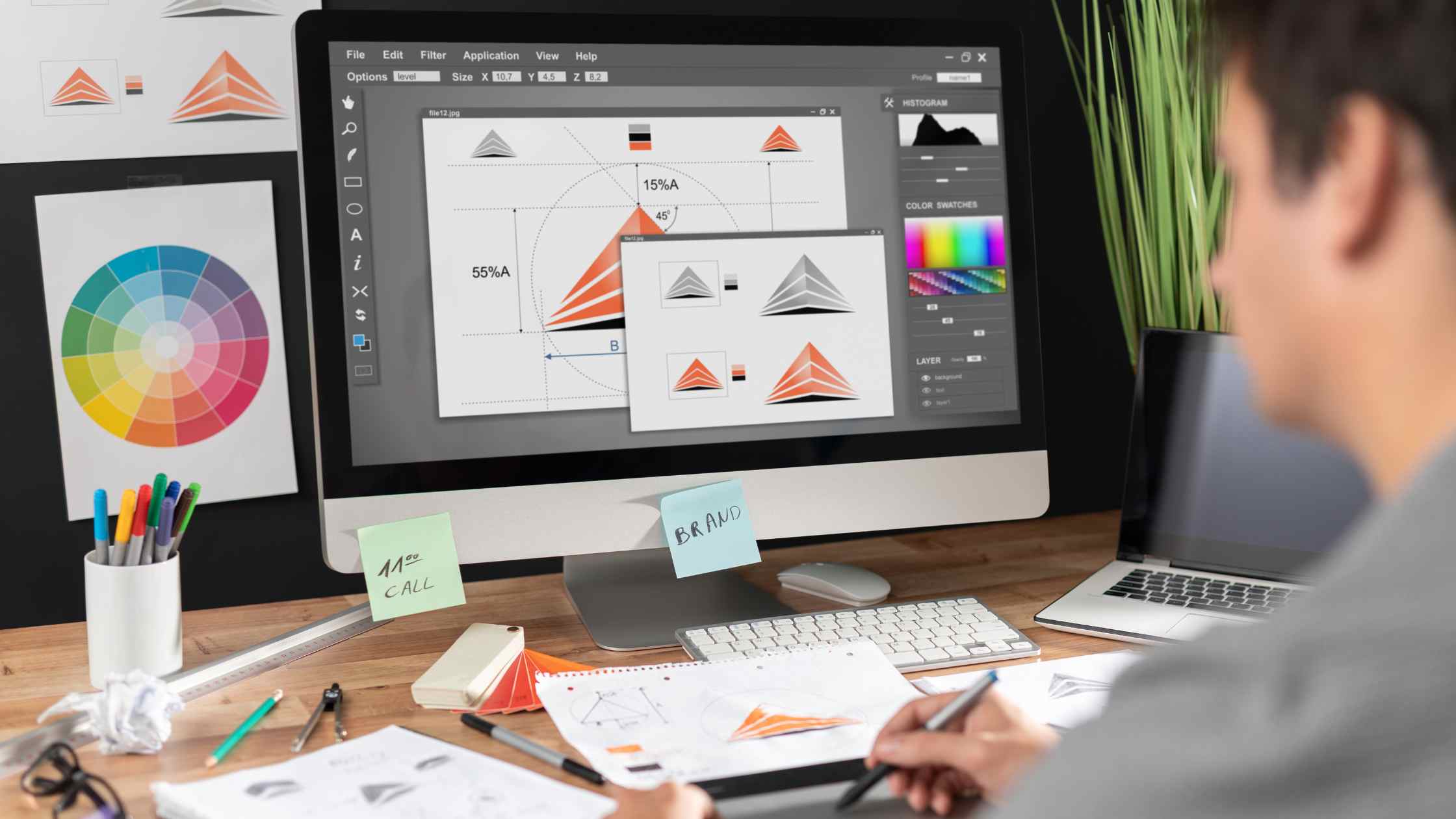Graphic Design Project Ideas for High School Students


Graphic design is a fascinating and fast-evolving field that meaningfully impacts an endless variety of industries and individuals. Embarking on graphic design projects in high school increases your knowledge, enhances your skills, showcases your talents, and provides exciting pathways to your continuing success, academically, professionally, and personally.
Let’s explore the many facets of graphic design and the best graphic design project ideas for students. Pay attention to the concepts and aspects that pique your interest and spark curiosity, as these will best guide the focus of your work. Steering your inquiries and investigations in directions that align with your interests drives the most impactful and rewarding results!
First things first. Familiarizing yourself with the basic concepts of graphic design will set you up for a more enjoyable experience, reducing frustration and building creative problem-solving skills.
Using the right tool for the job is key to success! This is quite literally true when diving into graphic design projects for students. Take a look at the most used and recommended technology and tools to kickstart your graphic design journey.
Logo design and branding focus on creating symbolic imagery that stands out and makes a strong impression. This type of project offers an excellent opportunity to practice and showcase your ability to apply design thinking, utilize key concepts, and create valuable work to include in your design portfolio.
Not all digital work stays digital. Print is very much alive and well in the graphic design world. It’s important to take into account the additional challenges of printing your project. Most importantly, layout margins, resolution, and file format.
Take your work from pixel to paper with posters, portfolios, magazines, flyers, and more. Explore these 5 great examples of design projects made for print.
Digital marketing and advertising are more relevant now than ever before. From social media platforms like TikTok, Instagram, and Facebook, to TV and streaming services like YouTube, digital marketing drives business.
Creating graphics for social media platforms focuses on user interaction and a specific set of design rules. Explore color combinations and font types to learn what grabs the audience’s attention!
Learn the basics of web design, like Layouts and navigation. See how sites work and look differently on different types of devices. Make a school club website, a personal portfolio page, or an app. Use tools like Figma, Adobe XD, and Canva. These projects give you real-world experience and a chance to build your portfolio!
Check out these animation project ideas for high school students.
Start with basic photo editing techniques like cropping, color correction, and retouching, then advance to creative manipulations like surreal composites, color splash effects, or mini photo essays. These projects let you explore contrast, hierarchy, movement, and aesthetics while building your collection of work.
1. Applied Photography & Branding
Design album or CD covers, advertising posters, magazine layouts, or social media campaign graphics. Incorporate typography, visual hierarchy, and balance. Produce professional-quality work that communicates a clear message.
2. Personal and Organizational Branding
Create a personal brand logo or a branding kit for a school club, sports team, or fictional startup. Use color theory, typography, and unity. Develop cohesive brand identity packages that showcase creativity and strategic thinking.
3. Digital Marketing and Web Design Projects
Build social media graphics, YouTube thumbnails, banner ads, or simple web pages and UI prototypes. Use tools like Canva, Figma, or Adobe XD. Emphasize layout, hierarchy, readability, and responsive design. Engage audiences effectively.
4. Packaging and Product Design Projects
Design product labels, packaging mockups, or integrated branding systems. Focus on everyday, food, tech, or fashion products. Explore proportion, contrast, repetition, and movement. Create visually compelling, professional-quality design work. Learn marketing and presentation skills.
Packaging and branding projects help you to explore how design communicates a product’s identity and appeals to an audience in real and functional ways. Practice professional design skills, consider real-world marketing and usability, and produce portfolio-ready work that shows both creativity and attention to detail.
Enhance your digital literacy. Learn what looks good and why. Explore design concepts like hierarchy, balanced spacing, and font readability.
Exercise 1
Logo Simplification: Take an existing brand logo and recreate it digitally. Use only basic shapes in Illustrator, Canva, or Figma. This builds vector skills while practicing balance and proportion.
Exercise 2
Photo Mood Edit: Choose one photo and edit it three different ways: bright, dramatic, and vintage. Focus on contrast, color adjustments, and lighting. Explore how mood changes with design choices.
Exercise 3
Font Pairing Practice: Pick two different fonts and combine them in a short text layout. Adjust size, weight, and spacing. Practice hierarchy and readability.
Exercise 4
Color Palette Challenge: Generate a five-color palette. Use Adobe Color, Coolors, or Canva. Apply the palette to a simple shape-based design, like an abstract background. Practice color theory and harmony.
Exercise 5
Quick Ad Mockup: Use Canva or Photoshop to design a simple banner ad. Use a short phrase and one image. Focus on clear typography and a strong call-to-action. Practice visual communication.
It’s never too early to start your portfolio! Maintaining digital portfolios is an impressive and practical way to showcase your skills and potential. When creating your graphic design portfolio, first ask yourself who your intended audience is. Decide what types of information and examples they would be interested in seeing. Choose pieces of work that could make you stand out in the crowd. Include any work you create, along with any training programs you’ve completed and skills you have acquired.
Look into these top creative arts competitions for high school students.
Feedback is important in graphic design because it helps you spot what’s working and what’s not. It’s not just about making things look good; it’s about learning what impact your design choices have. Hearing what others think also gets you ready for real-world design work, where clients and teammates have input.

Graphic design projects for students do more than teach how to create. This work helps build professional habits that prepare you for real-world work. From meeting deadlines to collaborating with others, these projects give you a taste of how the design industry works and develop skills that go beyond school.
Design projects require you to set goals, plan ahead, stay organized, and meet deadlines. Practicing these skills helps you balance multiple projects and manage your time effectively. Practicing this kind of discipline is key to your success in the design world. It also teaches you how to manage your time effectively so you can balance multiple projects and meet deadlines with confidence.
Working with others is a core part of graphic design. You’ll practice sharing ideas, giving and receiving feedback, and explaining design choices. Using tools like Figma or Google Workspace mirrors real workplace collaboration, helping you build confidence, adaptability, and the skills needed to succeed in a professional design environment.
In this day and age, we are fortunate to have an internet full of learning and teaching resources, many free and on-demand. From corporate courses to TikTok creators, when and how you learn is up to you. YouTube alone could be your own personal graphic design academy. So, whether looking to gain new knowledge, sharpen your skills, or find your next cool design project, start searching today!
Writer’s block isn’t just for writers. When you find yourself struggling to imagine creative and strategic next steps of your graphic design project, as all designers do, having creative block solutions in your strategic toolkit is key to success. In moments of blocked thought, redirection is key.
With college and work opportunities on the horizon, high school is an excellent time to start organizing your graphic design portfolio. This collection is a visual representation of what you can bring to the table. Portfolios can be both digital and print. Start collecting and organizing your projects, both big and small. Save everything, as even the smallest project can showcase skills and can be built upon over time.
Getting to know the graphic design world is a smart way to get ahead. Taking free online courses is a great way to gain insight into the current state of the field. Read articles and magazines, watch videos, and research your questions. Keeping up to date now will help prepare you for future work!
Whether you're pursuing graphic design in high school as a personal passion, a method to showcase and market yourself to schools, programs, and employers, or to build the foundation for a lifelong career, these graphic design projects are the building blocks you need to succeed and have fun doing it!



Do you have a project idea but aren’t sure how to bring it to life? Indigo Research connects high school students with academic mentors who help turn ideas into polished research projects. Many students choose to share their work through publications, competitions, or presentations. Completing this program strengthens your college applications and gives you early experience with university-level research.
.png)
Do you have a project idea but aren’t sure how to bring it to life? Indigo Research connects high school students with academic mentors who help turn ideas into polished research projects. Many students choose to share their work through publications, competitions, or presentations. Completing this program strengthens your college applications and gives you early experience with university-level research.